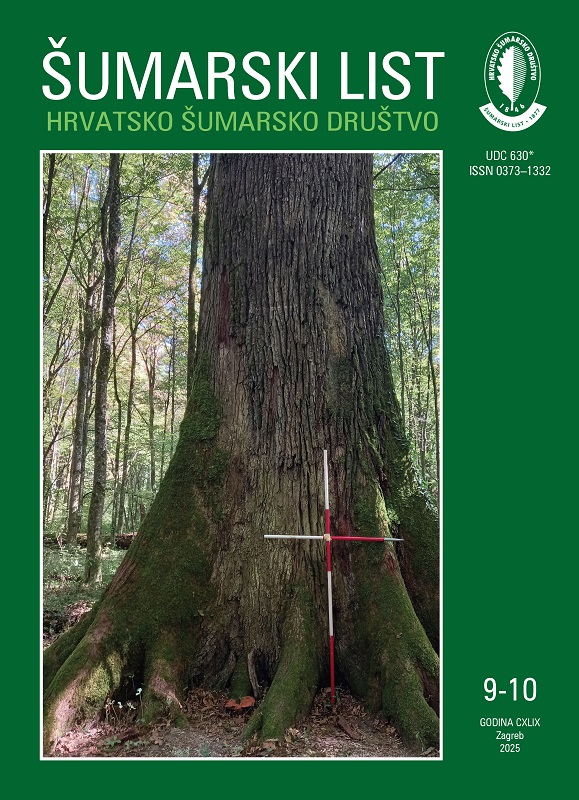| |
| RIJEČ UREDNIŠTVA |
| |
|
|
| Uredništvo HŠD | |
| No progress in forestry without science and without culture
pdf
HR
EN
|
409 |
| |
| IZVORNI ZNANSTVENI ČLANCI |
| |
|
|
| Ida Katičić Bogdan, Rudolf Stipetić, Antonio Vidaković, Marko Bačurin, Saša Bogdan, Zlatko Šatović, Igor Poljak | UDKps://doi.org/10.31298/sl.149.9-10.1 |
| Genetic diversity and genotyping of clones in clonal seed orchard of black pine (Pinus nigra J.F.Arnold)
pdf
HR
EN
|
411 |
The aim of this study was to assess the genetic diversity of clones within the clonal seed orchard of black pine (Pinus nigra J.F.Arnold, Pinaceae) located in the area of the Krk Forest Office, using morphological and molecular markers, and to conduct genetic identification (genotyping) of ramets to verify the accuracy of the orchard layout. The study included samples from 136 ramets across five populations. Microsatellite markers were used for the genotyping of clones, and morphometric analysis was carried out based on ten morphological traits of needles and cones. Significant differences were observed among clones and populations for all morphological traits examined. The average needle length was 89.8 mm, and the cones, averaging 55.7 mm in length and 26.8 mm in width, contained 106 seed scales. The orchard layout revealed 27.2% of mislabeled ramets, of which three belonged to different clones, while others had unknown genotypes. Main sources of error included scion die-off and growth of rootstock shoots, with labeling errors also being a possibility. Corrective actions should include proper labeling of misidentified ramets and the removal of individuals with unknown origins or genotypes. Future scions for orchard supplementation should be sourced exclusively from confirmed ramets. For specimens with branching discrepancies (where different genotypes were identified on two branches, one matching the designated clone), the incorrect branch must be removed as it originates from the rootstock. Comparisons with other studies on black pine using microsatellite markers indicate that the genetic diversity in the orchard (HE = 0.646) aligns with values found in natural populations. Since most clones originate from a limited number of populations, with some poorly represented, expanding the genetic base with newly selected clones is recommended if the orchard is to be maintained. Multivariate statistical methods did not reveal grouping of clones based on their original population affiliations. The results of this study hold practical value for forestry as seed orchards serve as a suitable base for ex situ conservation of genetic diversity and the production of genetically superior seeds for stand restoration or natural regeneration support. The findings also highlight the importance of accurate clone labeling to avoid negative consequences in managing clonal seed orchards.
|
| Jelena Kranjec Orlović, Fran Bono Cindrić, Darwin Damijanić, Damir Drvodelić, Mario Šango, Sanja Bogunović, Danko Diminić | UDKps://doi.org/10.31298/sl.149.9-10.2 |
| First report of Diaporthe eres associated with stem and branch canker on Quercus robur L. in Croatia
pdf
HR
EN
|
423 |
| Viktorija Brndevska Stipanović, Vlatko Andonovski, Saša Orlović | UDKps://doi.org/10.31298/sl.149.9-10.3 |
| Diversity of woody plants in urban parks of Skopje, North Macedonia
pdf
HR
EN
|
431 |
| Igor Poljak, Marijan Vuković, Ana Vuković, Matija Magdić, Antonio Vidaković, Ivana Zegnal, Doris Marjanović, Irena Šapić | UDKps://doi.org/10.31298/sl.149.9-10.4 |
| Leaf morphological variation in Ribes alpinum L. across elevation gradients in the north-western Dinaric Alps: evidence of phenotypic plasticity and habitat influence
pdf
HR
EN
|
443 |
| Neşe Gülci, John Sessions, Preston Green | UDKps://doi.org/10.31298/sl.149.9-10.5 |
| Assessment of tethered harvester productivity: a case study in western Oregon, USA
pdf
HR
EN
|
457 |
| |
| STRUČNI ČLANCI |
| |
|
|
| Zoran Šikić, Morana Bačić | UDKps://doi.org/10.31298/sl.149.9-10.6 |
| Spatial coverage of Natura 2000 forest target habitat types in Zadar County
pdf
HR
EN
|
467 |



